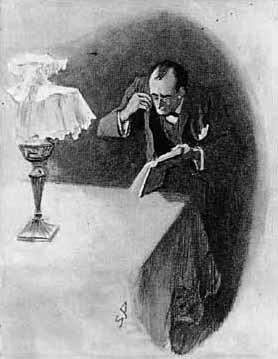A Scion Society of The Baker Street Irregulars

The 17 Steps: The Golden Pince-Nez
Seventeen thoughts for further ponderance of the case at hand – The Golden Pince-Nez (GOLD)

THAT’S ONE HEAVY TIN DISPATCH BOX
The ever-enigmatic Dr. Watson begins this week’s tale with those intriguing words, “When I look at the three massive manuscript volumes which contain our work for the year 1894.”
That’s not one, not two, but three whole volumes and, better still, they’re massive. Then there’s that word that has to set collectors’ mouths to “high drool”: manuscript.
Were these wondrous tomes the work of Watson alone? A combined record in the handwriting of both he and Holmes? How many cases might “three massive volumes” have held for 1894? Does this mean that Watson was recording every single one of Holmes’s cases for that year?
And one for the collectors: three massive volumes of crime chronicles in the handwriting of Dr. Watson, many, if not most, of the cases unpublished. How much money would such a thing go for if it were to show up at auction?
THE SECRET OF HIS SUCCESS(ION)
Among the untold tales we are presented with this time is “the famous Smith-Mortimer succession case.”
How many kinds of succession are there that might pertain to this case? Did Mortimer necessarily succeed Smith, or was their succuession something they shared or both caused? Or is this one just too vague?
HOW DULL WERE THE OTHER CASES?
Once more, Watson advertises this case up front in glowing terms that may not be backed up by the tale that follows: “On the whole I am of opinion that none of them unites so many singular points of interest as the episode of Yoxley Old Place, which includes not only the lamentable death of young Willoughby Smith, but also those subsequent developments which threw so curious a light upon the causes of the crime.”
So *many* singular points? Well, there’s the murder, the hidden panel, and the secret past … and after “Norwood Builder” that panel isn’t so distinctive. What were the “many” singular points Watson finds in this case?
HOW PROFITABLE WAS THE EVENING FOR WATSON?
“Holmes and I sat together in silence all the evening, he engaged with a powerful lens deciphering the remains of the original inscription upon a palimpsest, I deep in a recent treatise upon surgery.”
Well, we know Holmes wasn’t too happy with the results of his studies, but what of the doctor? If Watson had sold his practice to Holmes’s cousin, why was he reading up on surgery? Would this be a “how-to” treatise, or a study of some form of surgery? How often would Watson have been practicing surgery even if he was in practice?
SLOSHING YOUR WAY DOWN BAKER STREET
“I walked to the window, and looked out on the deserted street. The occasional lamps gleamed on the expanse of muddy road and shining pavement. A single cab was splashing its way from the Oxford Street end.”
Time for some very basic questions: How much “mud” was there coating Baker Street? There was pavement under there somewhere wasn’t there? Was there anyway for the dirt on the streets to wash off to?
WHERE WAS THE NEAREST CABSTAND?
For a promising young detective, Stanley Hopkins seems very free with his transportation, sending his cab away before he even knows Holmes is home, on a very unpleasant night to be walking home. What were his hopes for finding fresh transportation in that weather if he hadn’t stayed?
A PRACTICAL MAN’S USES FOR A SCOTLAND YARD MAN
“It was young Stanley Hopkins, a promising detective, in whose career Holmes had several times shown a very practical interest.”
Why was it so practical for Holmes to show an interest in Hopkins’s career? Wasn’t his connection to the Yard already well established?
GOOD MEDICINE FROM THE GOOD DOCTOR
“Here’s a cigar, and the doctor has a prescription containing hot water and a lemon, which is good medicine on a night like this.”
What else might have Watson’s prescription contained? Was this an actual attempt at a cold remedy or a bit of wassail for the caroller of criminal tales?
THE YOXLEY OLD PLACE BIOSPHERE
“If you were to search all England, I don’t suppose you could find a household more self-contained or freer from outside influences. Whole weeks would pass, and not one of them go past the garden gate.”
Would such self-containment have required any special measures in that much more self-sufficient time? What supplies might they have needed to break their solitude occasionally to go out for? How long could such a household have gone without outside contact, at the outside limit?
THE MORTIMER THAT DIDN’T KNOW ANY BASKERVILLES
“Mortimer, the gardener, who wheels the Bath chair, is an army pensioner–an old Crimean man of excellent character. He does not live in the house, but in a three-roomed cottage at the other end of the garden.”
Does Hopkins mean Mortimer fought in Crimea, or that he’s actually of Crimean descent? Wasn’t a three-roomed cottage a luxury for a gardener at a household the size of Yoxley Old Place? We are told that Coram couldn’t dress without the help of Mortimer, which, combined with the bath-chair business, shows that Mortimer’s duties went far beyond gardening. Was he still referred to as the “gardener” because his employer was sensitive about his invalided state and would not abide having a “nurse”?
THE REASONS FOR REDECORATING
We are told that Susan Tarlton “was engaged at the moment in hanging some curtains in the upstairs front bedroom. Professor Coram was still in bed, for when the weather is bad he seldom rises before midday. The housekeeper was busied with some work in the back of the house. Willoughby Smith had been in his bedroom, which he uses as a sitting-room.”
The upstairs front bedroom plainly belonged to neither Coram nor Smith, as they both were occupying theirs. Being the front bedroom, it would seem the logical choice for overnight guests. Why was Susan suddenly hanging curtains in that bedroom, when the household seems so unsocial? Was Coram expecting a guest? Or was it just time to wash the curtains and the merest coincidence to all that happened in the tale?
KNIVES FOR EVERY POSSIBLE PURPOSE
In this tale we find “one of those small sealing-wax knives to be found on old-fashioned writing-tables, with an ivory handle and a stiff blade.”
How does a knife come into play in the process of administering sealing wax or opening an envelope sealed with such wax? Is it like a letter opener, a convenient, but basically unnecessary item?
AND THIS WAS THE SCOTLAND YARD MAN HE LIKED
“What did you do, Hopkins, after you had made certain that you had made certain of nothing?”
In this tale, Holmes gives Hopkins a little bit of the criticism he usually saves for Watson. Were Holmes’s little digs a measure of how comfortable he was with an individual? Might his tone have been humorously such that these bits were less stinging than they sometimes appear?
STANLEY HOPKINS — MEMORY CHALLENGED?
Sherlock Holmes makes several deductions from the golden pince-nez found at the scene of the crime, which is not an unusual thing for him to do. What is a bit different is the fact that he writes them all on paper first, rather than just announcing them aloud, as is his usual fashion. Why? Though his write-up starts in the form of an advertisement, it finishes as suggested instructions for the investigator. What purpose did this write-up have?
THE LONG HOURS OF POLICE WORK
“I had intended,” Hopkins says, “to go the round of the London opticians.”
Didn’t London have a good-sized number of opticians even then? Just how long would it have taken Hopkins to do the legwork involved in such an effort, even with the help of a hansom?
THE HOSPITALITY OF 221B
“Well, it’s nearly one, and we had best get a few hours’ sleep. I daresay you can manage all right on the sofa in front of the fire. I’ll light my spirit lamp, and give you a cup of coffee before we start.”
Didn’t 221B Baker Street have a guest room at some point? Hopkins isn’t the first Scotland Yard man to sleep in the sitting room, but he’s the first that requires a night-light. Or is Holmes’s spirit lamp to be used in the brewing of coffee, and why would the detective have brewed it himself? Didn’t Mrs. Hudson keep he and Watson well supplied with coffee and breakfast?
PRODUCT PLACEMENT, VICTORIAN STYLE
“Is it a simple key?”
“No, sir, it is a Chubb’s key.”
Would this have qualified as a commercial for Chubb’s locks and keys? Or was “Chubb’s” a brand like Xerox or Kleenex that came to be commonly used as the word for a product that other companies produced as well?
AND WHEN THEY GOT DESPERATE, THEY MADE MAT CREAM PIE
“The professor’s corridor is also lined with cocoanut matting.”
This one has always mystified me: What part of the cocoanut did they make matting out of?
APPARENTLY, HE DIDN’T MAKE IT
Coram brags, “That is my magnum opus–the pile of papers on the side table yonder. It is my analysis of the documents found in the Coptic monasteries of Syria and Egypt, a work which will cut deep at the very foundation of revealed religion. With my enfeebled health I do not know whether I shall ever be able to complete it, now that my assistant has been taken from me.”
How might knowledge from the Coptic monasteries have cut out the foundation of revealed religion? Is he speaking strictly of a specific religion, or all religion? Would he have found a sympathetic reader in Holmes, who enjoyed Winwood Reade’s “Martyrdom of Man” so much?
HOW DID SHE KNOW HER CUE?
“She is there,” announces Sherlock Holmes, pointing to a bookcase, behind which Anna Coram was hidden. Mrs. Coram has lost her glasses, and even if she had them, we’re not told whether or not she had a peep-hole. How did she know that Holmes’s “She is there.” was directed at her and not a maid in the doorway?

The Seventeen Steps originally appeared on the Hounds of the Internet e-list from September 2000 to October 2001 and later on the Sherlock Peoria blog.
Brad Keefauver, the 41st Garrideb, is the author of The Elementary Methods of Sherlock Holmes, Sherlock and the Ladies, and The Armchair Baskerville Tour. Former publisher of The Holmes & Watson Report, The Dangling Prussian, and a whole lot of obscure, collectable little things on our boy Sherlock. Keefauver is a member of the Baker Street Irregulars and the Adventuresses of Sherlock Holmes.

Sorry, comments are closed for this post.